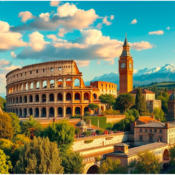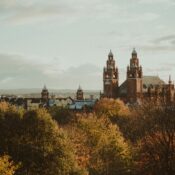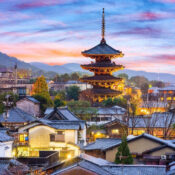21 Best Amazing Places to Explore In Delhi
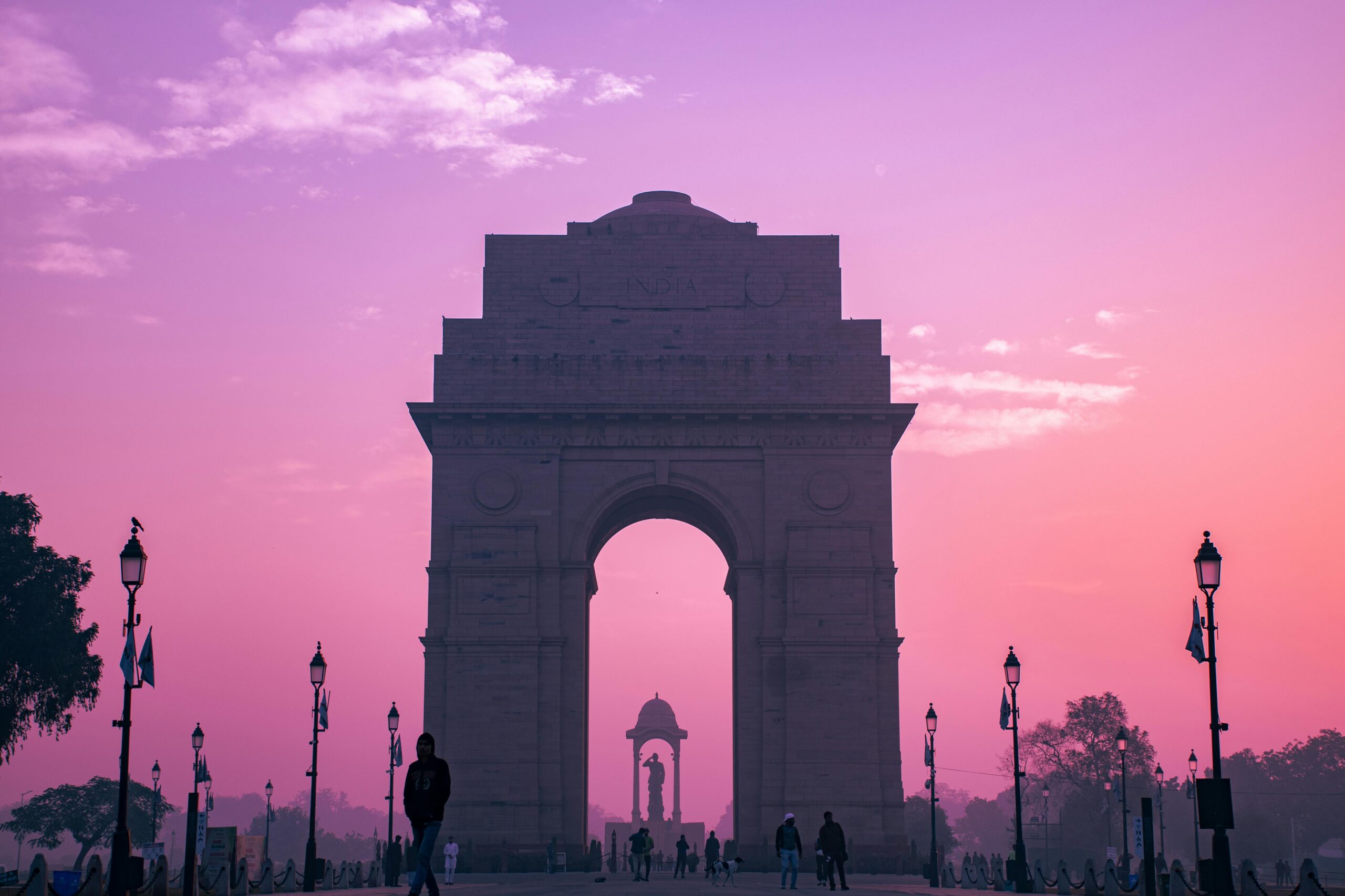
21 Best Amazing Places to Explore In Delhi
Delhi is a city and a capital of India. It is home to the two different worlds of New Delhi and Old Delhi. The nation’s modern capital and seat of government is in the former, which the British established in 1931 as the imperial capital. On the other hand, many view Old Delhi as the symbolic center of the larger metropolitan area.
With a population of around 20 million, Delhi is one of the most populated regions on earth. It is significant as both India’s busiest international gateway and a religious hub, combining history and modernity in a heady mix. Its history is as old as that of the Yamuna River, which is one of Hinduism’s holiest rivers and serves as a natural border between Old Delhi to the east and New Delhi to the west.
There are a plethora of sights and activities to enjoy in Delhi and New Delhi, such as exploring the city’s varied arts and crafts sector, numerous stunning monuments, and innumerable performance spaces. The region is renowned for its outstanding food, which features cuisine from all around India. With its plethora of markets and bazaars, including Chandni Chowk, the most well-known shopping district in the nation, Delhi is a shopper’s dream.
With our list of the top tourist attractions in Delhi, India, you can discover the greatest spots to visit in this energetic, bustling city.
Best Places to Visit in Delhi:
Below are the best places to visit:
1. Red Fort, Delhi:
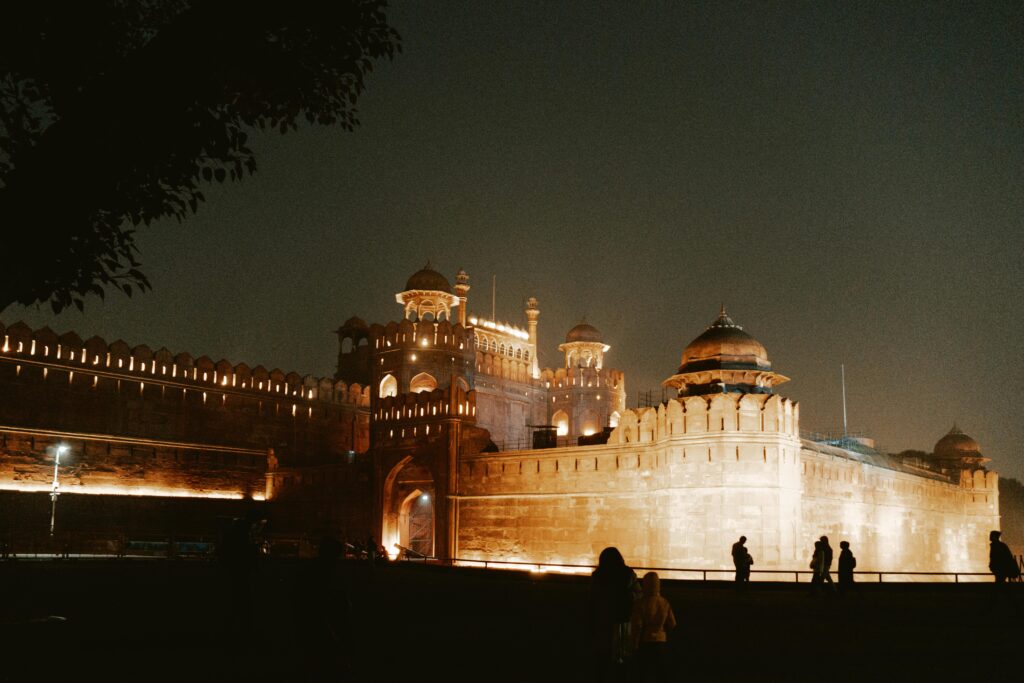
Shah Jahan constructed the stunning Red Fort (Lal Qila) in 1648. and it remained the centre of Mughal authority until 1857. This magnificent building, which crescent -shaped and encircled by a moat, occupies an area of more than two square kilometers. and is enclosed by thick red sandstone walls.
The bigger Delhi Gate was utilized by the emperor for ceremonial processions, while the striking Lahore Gate, which faces Lahore in Pakistan, gets its name from this fact. Passing through the Lahore Gate, tourists arrive at Chhatta Chowk, a covered bazaar from the 17th century that sells food and souvenirs as well as silks, jewelry, jewels, and silverware.
The musicians who performed for the emperor were once kept in the Naubat Khana within the Red Fort. and its exquisite galleries still hold a variety of fascinating musical instruments, including cymbals, gongs, and kettledrums. The magnificent white marble of Diwan-i-Am, the Hall of Public Audiences. where the emperor would receive his subjects, is another reason to visit.
2. Qutub Minar, Delhi:
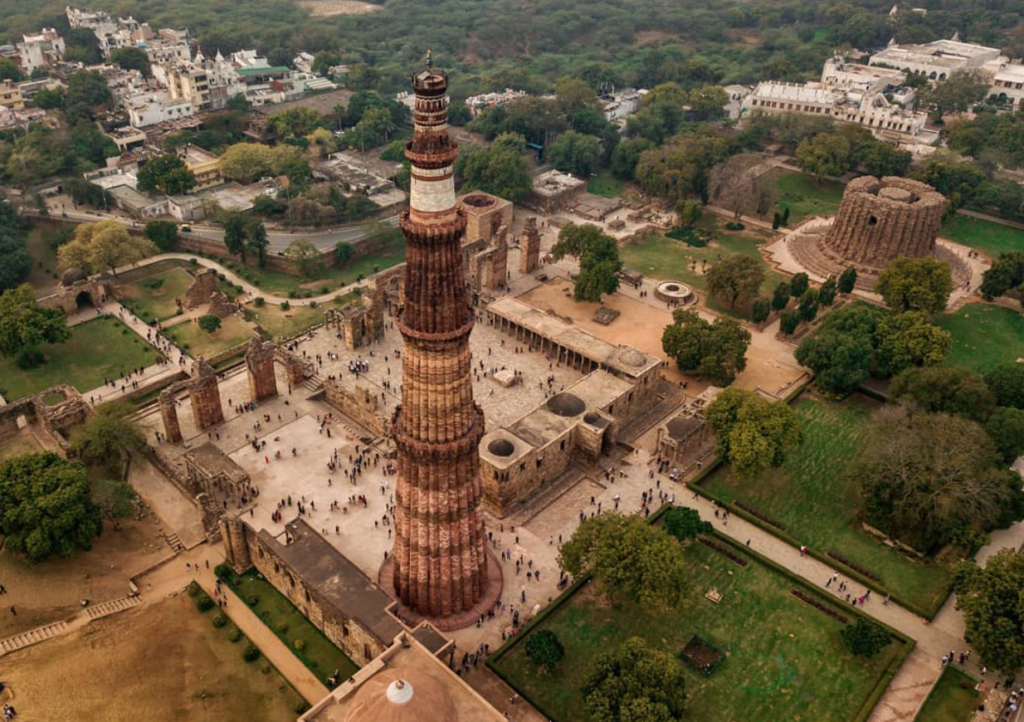
The stunning Qutub Minar, India’s highest minaret, was finished in the twelfth century. Now recognized as a UNESCO World Heritage Site. It draws tourists from all over the world who are anxious to reach the summit to take in the breath-taking vistas of the surroundings.
Rising more than 70 meters, this elaborate five-story tower decorated in detailed carvings that depict Qutub’s history and contain passages from the Koran. It’s also noteworthy for being built of several distinct kinds of stone. Marble and sandstone were used to build the fourth and fifth stories, while red sandstone made up the first three stories.
The complex also houses the tombs of Altamish, Alauddin Khalji, and Imam Zamin, as well as the Quwwat-ul-Islam Masjid. a mosque located at the base of the tower, and a gateway constructed in 1310. The 2,000-year-old Alai Minar, also known as the Iron Pillar, is well worth seeing.
3. Lodi Gardens,Delhi:
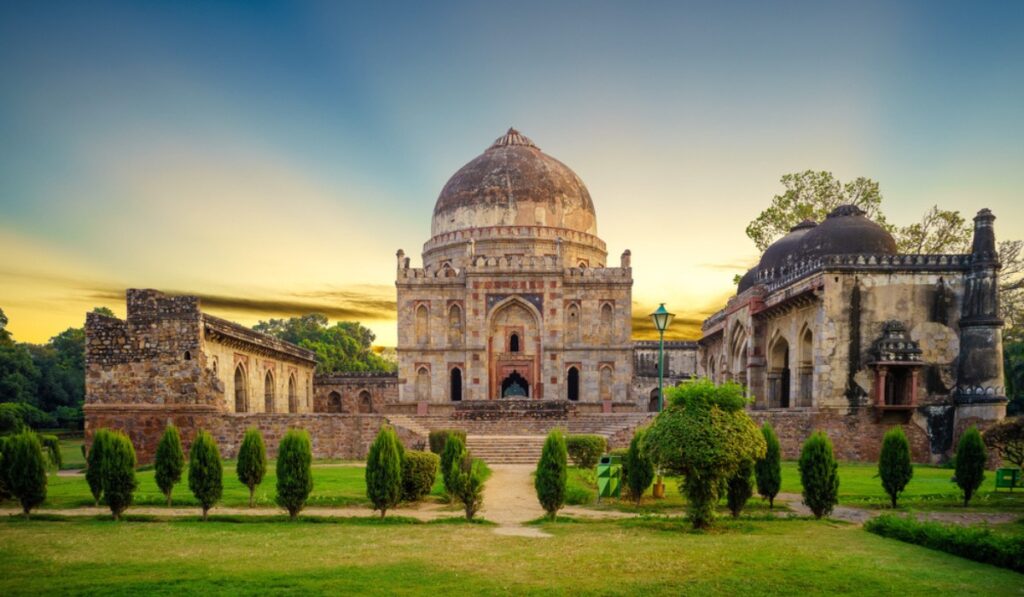
The 90-acre Lodi Gardens is one of the most well-liked parks in New Delhi among residents. so be sure to include it on your itinerary when visiting Delhi. Apart from its verdant grounds, the park is home to a multitude of artifacts from the Lodi era before to 1600, including as significant tombs and ruin sites.
Highlights of the building’s architecture include the Lodi Sultans’ tombs from the 15th century. a charming triple-domed mosque called the Glazed Dome (named for its blue tiles). and the remnants of a massive dome that was built in 1490. Make sure you also search for the Athpula, a 16th-century eight-pier bridge that spans the park’s lake and features lovely columns and arches.
In addition, Lodi Gardens is well-known for its abundant birdlife, 50 kinds of butterflies. and over 100 different varieties of natural trees. The National Bonsai Park of the nation is located there as well.
While you’re in the area, stroll the quick five minutes to the well-known Khan Market. In fact, this busy (and extremely safe) region is one of the most prominent shopping districts in the world. where street sellers selling local specialties coexist with expensive brands.
4. Gurudwara Bangla Sahib:
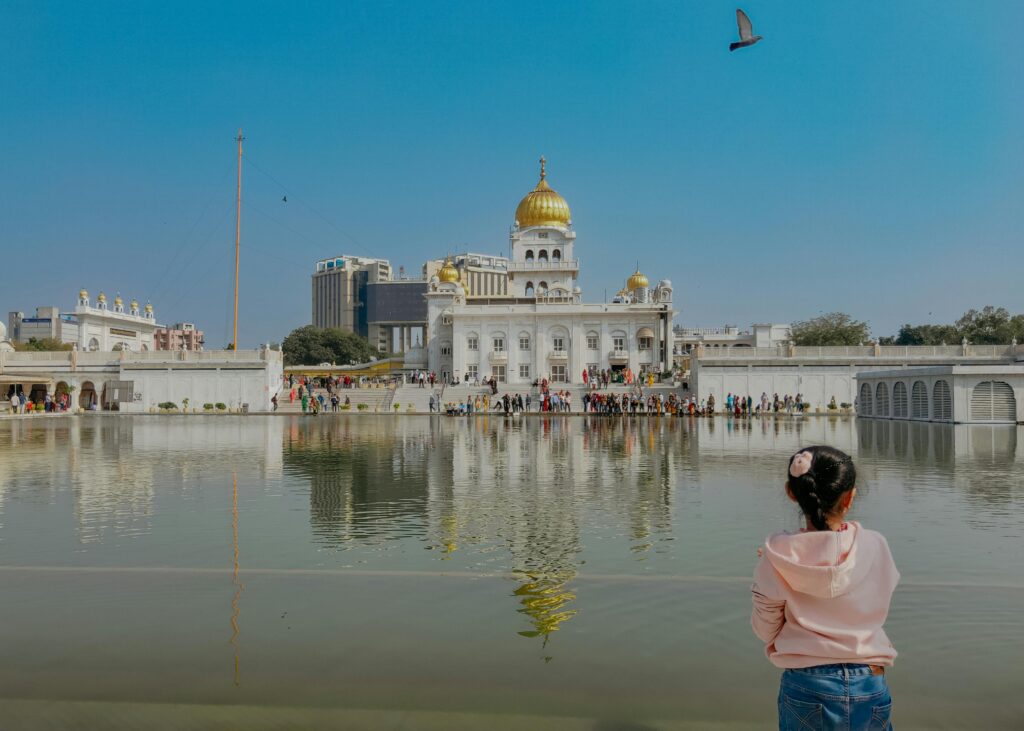
The 18th-century Gurdwara Bangla Sahib, Delhi’s most significant Sikh site of worship. is conveniently close to Connaught site and is well worth a visit. Highlights include its famed gold dome and flagpole, as well as its spectacular pool, the Sarovar, located at the center of this expansive complex.
Along with its art gallery and a modest museum devoted to the history of the Sikh religion. The huge temple edifice itself is very noteworthy. Here, guests are always welcome, and the spacious Gurdwara Kitchen serves a delicious lunch at no cost. In exchange, all we ask is that your shoes be taken off (free headscarves and shoe storage are supplied) and your hair be covered.
5. Lotus Temple:
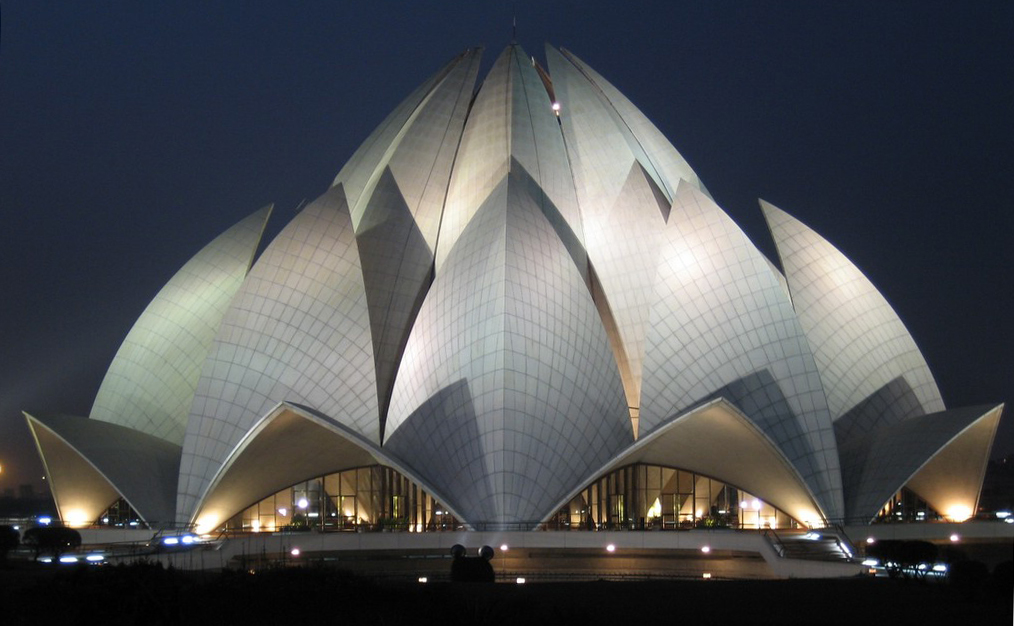
The beautiful Bahá’í House of Worship, with its breathtaking central dome and nine sides, also known as the Lotus Temple. It is a marvel of architecture. The entire structure, which made of marble and white concrete, has the delicate appearance of the flower it meant to represent. It rises from the nine pools of water around it, seeming as though it could bloom at any time.
Since its construction in 1986, the temple has welcomed over 70 million tourists, making it one of the most popular tourist destinations worldwide. Remarkably, this amazing house of worship is devoid of idols, religious images, or other religious symbols.
One of the largest Krishna temple complexes in the nation, the ISKCON Temple, is another contemporary temple well worth a visit.
6. India Gate, Delhi:
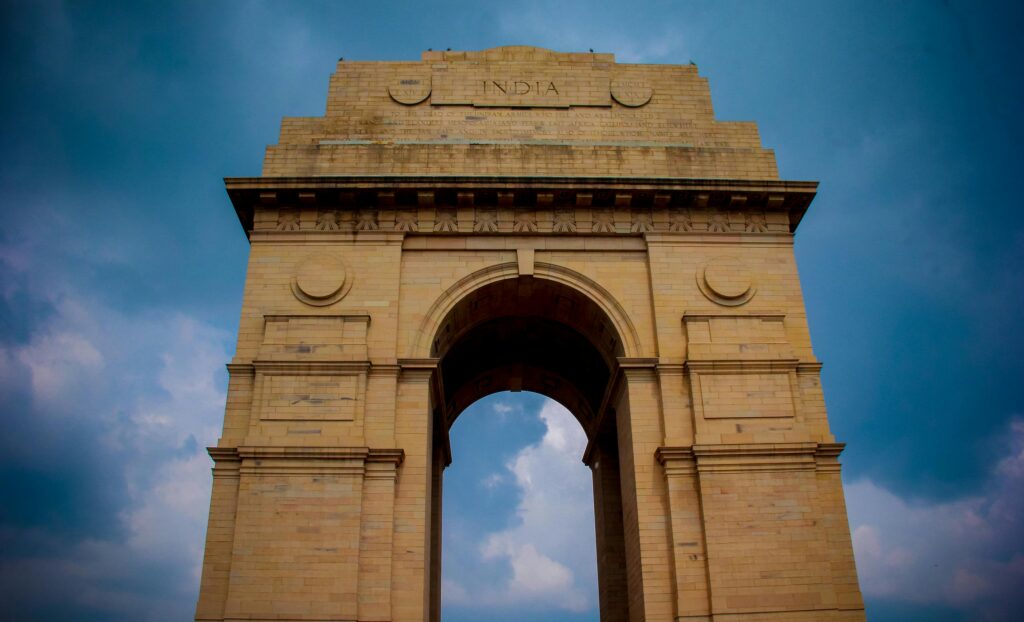
The equally spectacular India Gate a majestic stone arch designed as a memorial to Indian soldiers slain in World War I. It has a striking resemblance to the well-known Arc de Triomphe in Paris. Beneath the colossal edifice, an unending flame flickers. and the names of over 90,000 troops who lost their lives throughout the fight etched on its walls.
Raised on a red stone base, the structure dominates the parkland surrounding it. which is always bustling with crowds of people enjoying picnics or just lounging around. On important anniversaries, the shallow domed bowl on top of the structure occasionally filled with burning oil.
Witness the India Gate at night for a true delight; it’s regarded as one of the best free things to do in New Delhi. When it’s floodlit, together with the surrounding fountains, it’s a marvel to behold.
7. Jama Masjid:
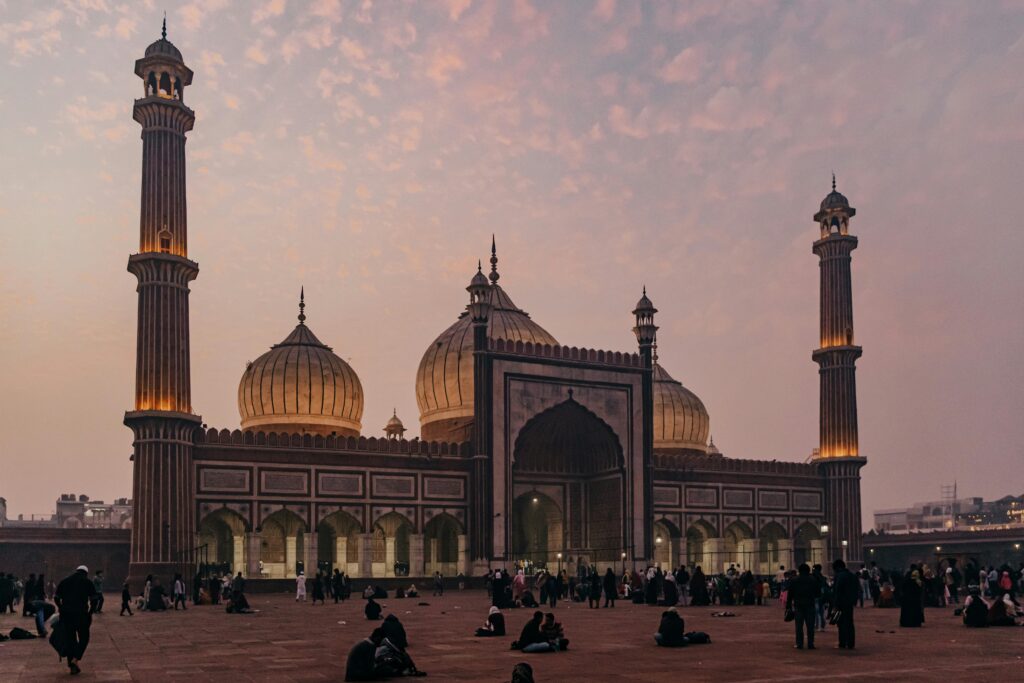
One of the biggest mosques in India, the Jama Masjid was Shah Jahan’s last architectural achievement. This stunning building finished in 1658 and has three entrances, four angled towers. and two 40-meter-tall minarets made of white marble and red sandstone that tastefully alternated in vertical stripes.
After taking in the breathtaking views of Old Delhi from the top of the southern minaret. Visitors can visit the spacious central pool, which utilized for pre-prayer cleansing. Please be aware that non-Muslims are not allowed during prayers; guests must remove their shoes and dress suitably before entering.
After that, don’t miss Chandni Chowk, the enormous central avenue of Old Delhi and a marketplace devoted to dining and shopping. Famous spice markets Naya Bazaar and Gadodial are particularly interesting. Here, hundreds of goods, including as pickles, chutneys, ginger, pomegranates, saffron, lotus seeds, and aniseed, are on exhibit.
8. Humayun Tomb, Delhi:
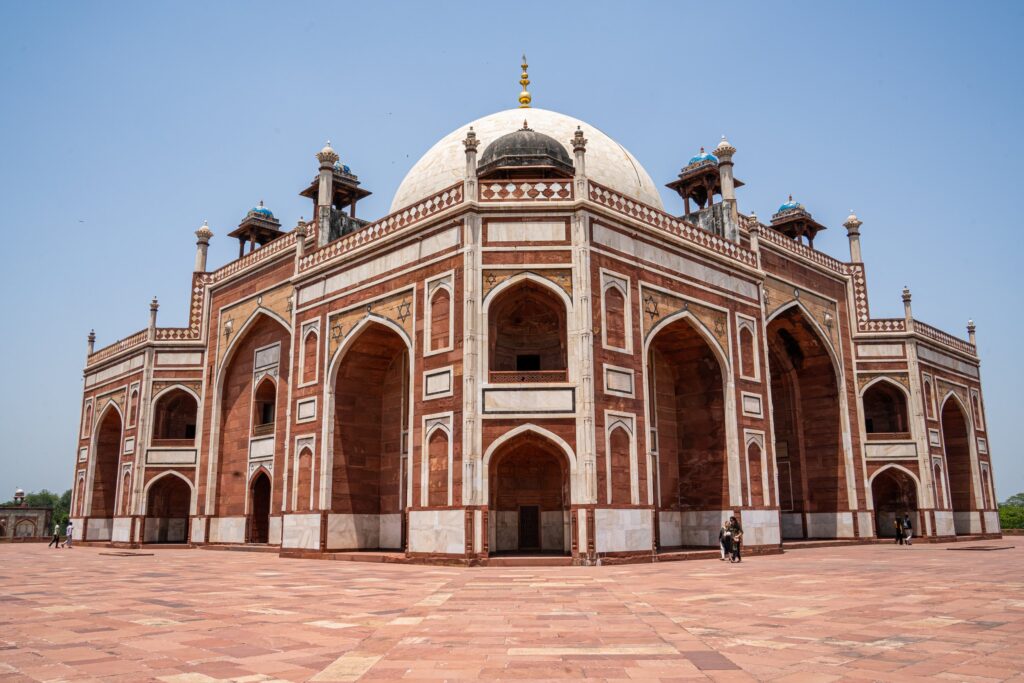
Humayun’s Tomb a tall mausoleum made of red sandstone and white marble that situated in a gorgeous, spacious square garden. It a superb example of Mughal architecture and intended to be the model for the Taj Mahal in Agra.
Constructed in the middle of the 16th century by Haji Begum as a tribute to her spouse by Humayun’s elder widow. The tomb encircled by luxuriant formal gardens and additional tombs, such as the barber of Humayun and the Tomb of Isa Khan (the mastermind behind the Taj Mahal). an exquisite illustration of Lodi architecture with an octagonal form.
Trying to get a peek of this amazing edifice when it’s lit up after dusk a wonderful activity to do.
9. Akshardam,Delhi:
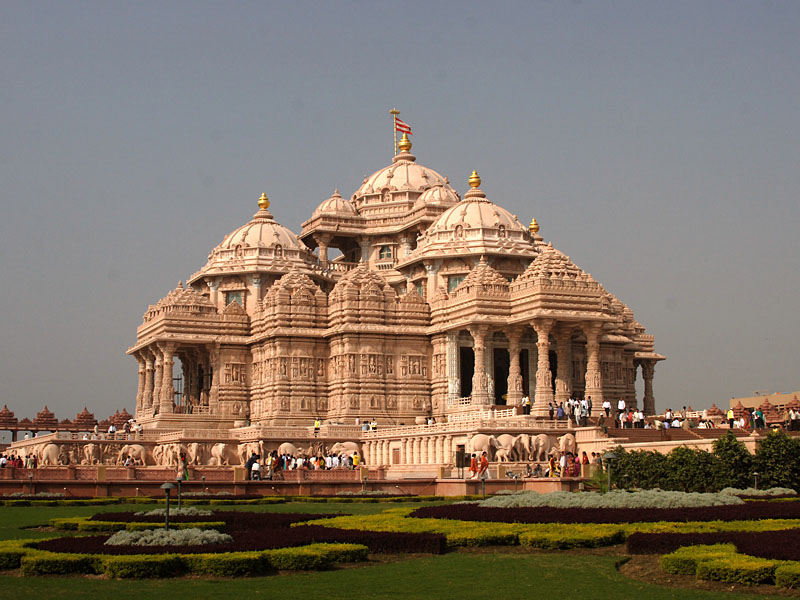
The magnificent Hindu Akshardham temple may have been built lately (it opened in 2007), but it appears to be centuries older. This spectacular edifice, adorned with complex carvings, draws many people due to its majestic grandeur.
Highlights include the magnificent 43-meter-tall main monument. which is adorned with intricate marble and pink sandstone carvings of gods, animals, plants, dancers, and musicians. Its nine domes are supported by 234 elaborate pillars, and its magnificent stone homage to elephants. which is centered by a 3,000-ton statue of one of these animals, is especially noteworthy.
A fascinating 15-minute boat journey that illustrates India’s rich history. And varied culture is one of the building’s other interesting elements. Another is the magnificent Yagnapurush Kund, a sizable melodic fountain that is especially lovely at night.
10. Purana Qila:
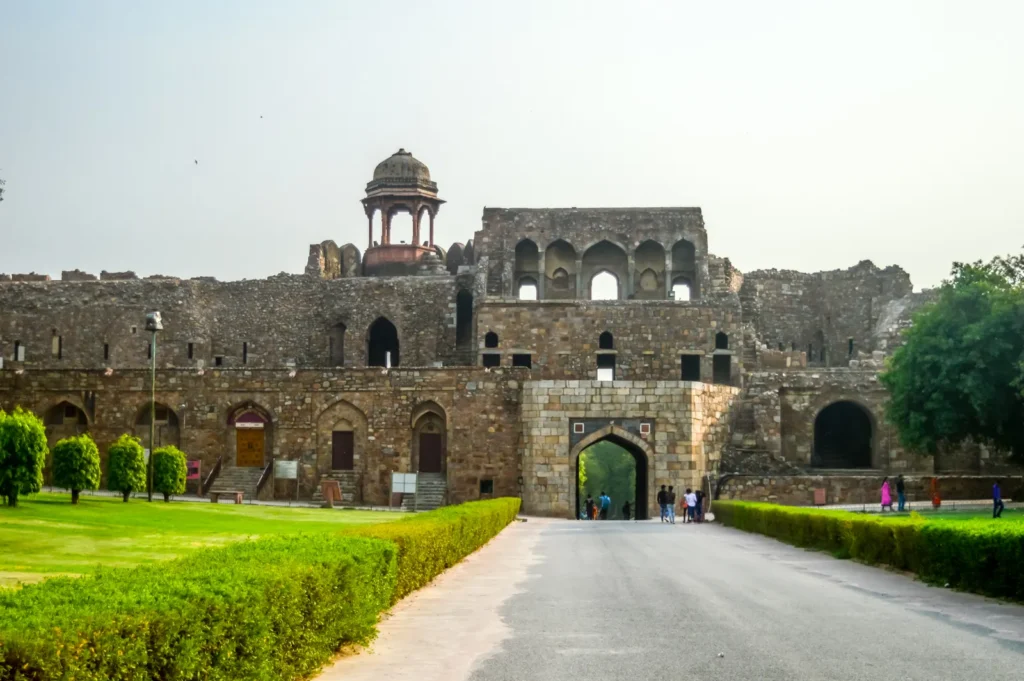
Purana Qila (Old Fort), though frequently disregarded since most visitors go directly to the more well-known Red Fort. It is worth fitting into your trip schedule while in Delhi. With a roughly 2,500-year history, most of the magnificent building that stands now was built in the 1500s. There have been traces of older constructions found that go all the way back to the third century.
Buildings like the Qila-i-Kuna Mosque, a single-dome place of worship constructed in 1541. proof that the Muslim religion had a significant influence on the current structure. which played a significant role in the region’s affairs for centuries. The two square kilometer complex is worth touring, with its thick ramparts. And three big gates making for an especially striking image at night when the lights go on.
Visit the 200-acre Mehrauli Archaeological Park, which has many significant buildings, some of which are over a millennium old. Highlights include the ancient Lal Kot ruins and more modern proof of British control during Queen Victoria’s reign.
11. Rashtrapati Bhawan:
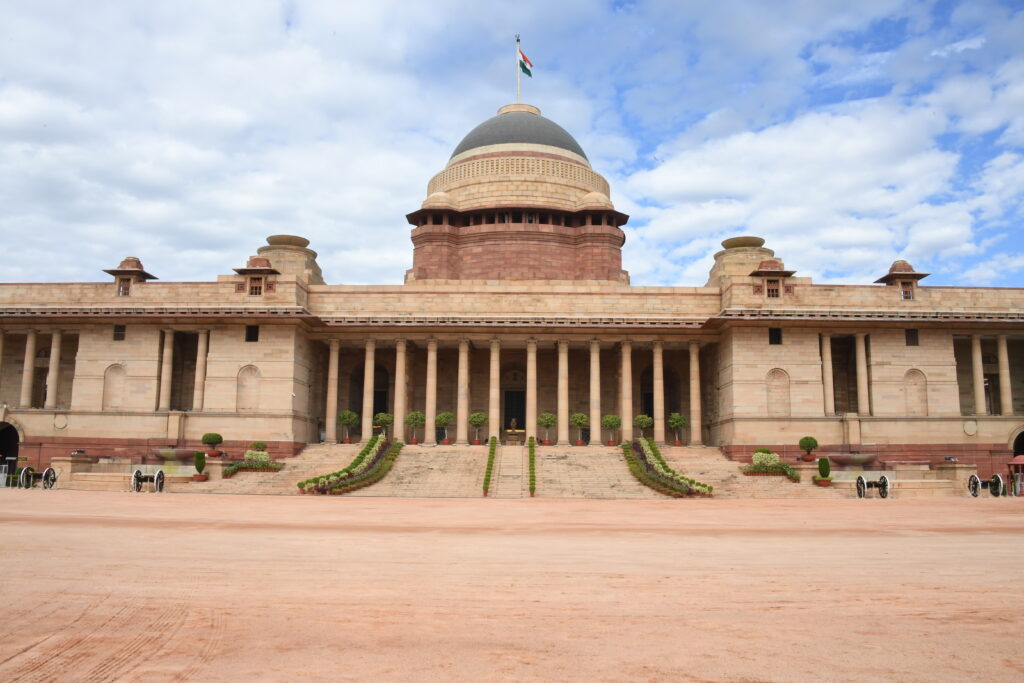
The ceremonial boulevard of New Delhi called Rajpath, or the King’s Way. It begins at Rashtrapati Bhavan, the official presidential house, and travels via India Gate, Vijay Chowk. and other significant city sites to the National Stadium.
This wide boulevard, which has ponds, grass, and trees on either side. comes to life on January 26th for the Republic Day Parade. Countless thousands of people come together to commemorate the anniversary of the nation’s independence on this unique occasion.
One of Delhi’s most spectacular structures is without a doubt the President’s Residence. Also known as Rashtrapati Bhavan (formerly the residence of the British Viceroy). Located at the western end of Rajpath. With about 340 exquisitely furnished apartments and an eclectic blend of European and Mughal architectural elements, it’s a great spot for a selfie.
The recently opened Rashtrapati Bhavan Museum is particularly noteworthy since it provides an interesting look inside the structure and features exhibits about former presidents.
Hot Tip: Look at the beautiful display of plants surrounding the President’s Residence in the nearby Mughal Gardens if you’re there in February or March.
12. Mahatama Gandhi memorial:
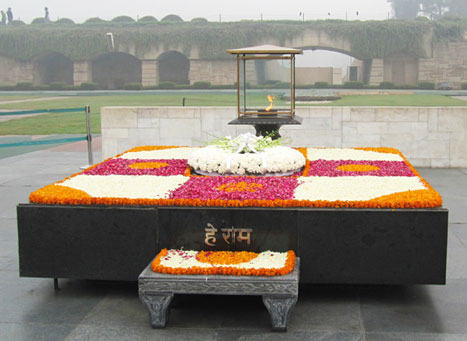
Delhi filled with references to Mahatma Gandhi, which is evidence of the man’s lasting influence. Gandhi Smriti (Gandhi Remembrance), a museum located in the home. where the renowned leader of the Indian independence struggle slain in 1948, arguably the greatest of the many attractions dedicated to him.
Highlights include the new Eternal Gandhi Multimedia Museum, which has historical records describing his many accomplishments, and exhibitions and artifacts connected to both his life and death, including the room in which he stayed, left exactly as it was at the time.
The opportunity to stroll around the exact gardens where Gandhi used to spend a lot of time is especially memorable (the Martyr’s Column marks the location of the shooting). A short stroll away, at the location of Gandhi’s cremation, is the Raj Ghat memorial, which is also worth seeing.
13. Janter manter Observatory, Delhi:
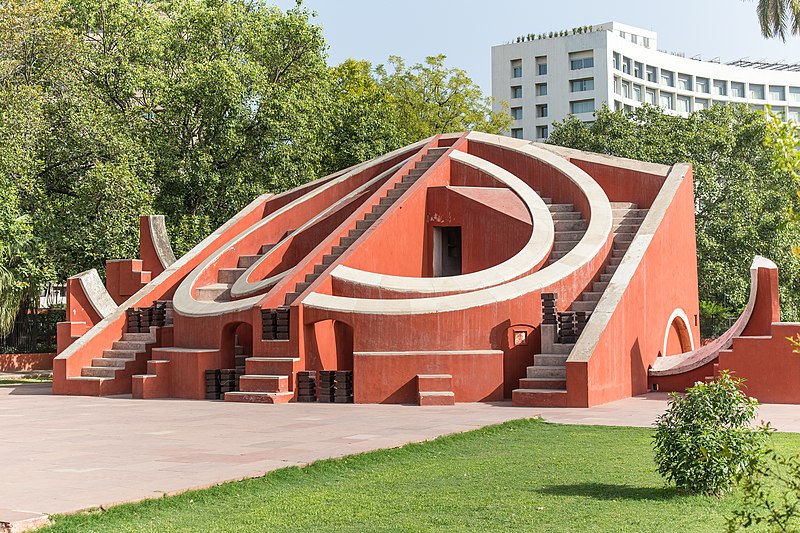
The largest and most well-known business district in New Delhi is Connaught Place, where Jantar Mantar situated. Maharajah Jai Singh I built five astronomical observatories, including Jantar Mantar, in 1725.
This well-preserved historic facility built to allow visitors to see the motions of the sun, moon, and planets. It also has a few other antique devices on exhibit that originally used to follow the path of celestial bodies and forecast eclipses. One of this amazing building’s architectural highlights the huge sundial known as the Prince of Dials.
14. Indira Gandhi Memorial Museum:
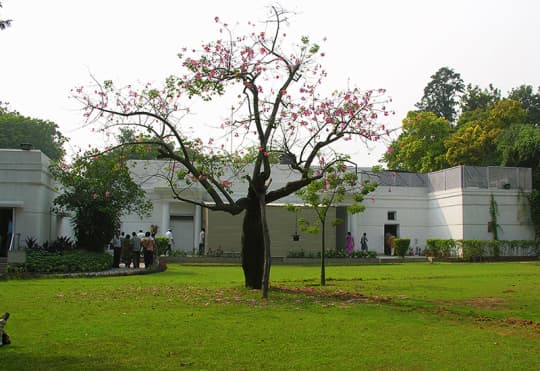
The Indira Gandhi Memorial Museum, located in the former home of this venerated figure (while she was unrelated to Mahatma Gandhi. she was the daughter of Jawaharlal Nehru, the country’s first prime minister), another significant politician-related site.
Highlights include pictures from her life and her stint as prime minister, news articles, letters, and personal items like the sari she was wearing when she was killed.
The building surrounded by an enclosed garden with mature trees and floral plants; the pathway leading through the garden is now a memorial, with a visible marker indicating the location of her assassination. In memory of her assassinated son Rajiv Gandhi in 1991, many rooms have set aside.
The equally fascinating Nehru Museum and Planetarium (Teen Murti Bhavan), located in his former home, honors Indira Gandhi’s father, Nehru. Highlights of the leader’s life and work shown in the museum, together with significant artifacts related to the freedom movement. His bedroom, drawing room, and study are home to exhibitions that showcase his professional achievements.
15. National Museum,New Delhi:

One of the biggest museums in India, the National Museum in New Delhi, has galleries that organized historically and feature artifacts from all significant eras. Archaeological discoveries are among the highlights, as are displays of terracotta toys, pictures and pots, jewelry, seals, bronze and copper tools, musical instruments, tapestries, tribal masks, swords, and paintings.
The Central Asian exhibit, which features sculptures, wall murals, silk banners, and artifacts relating to life along the historic Silk Route that connected Europe and China, is the most noteworthy gallery. Tours and audio guides available.
Some museums that are well worth seeing are the National Museum of Natural History, which focuses on the rich flora and fauna of the nation, and the National Science Centre, which is among the biggest science centers in the world.
The National Gallery of Modern Art (NGMA), which is home to the most significant art collections in the nation, is also noteworthy. Its more than 14,000 pieces of art, including by renowned Indian artists from the 1850s onward, displayed when it opened in 1954.
16. Laxminarayan Temple:
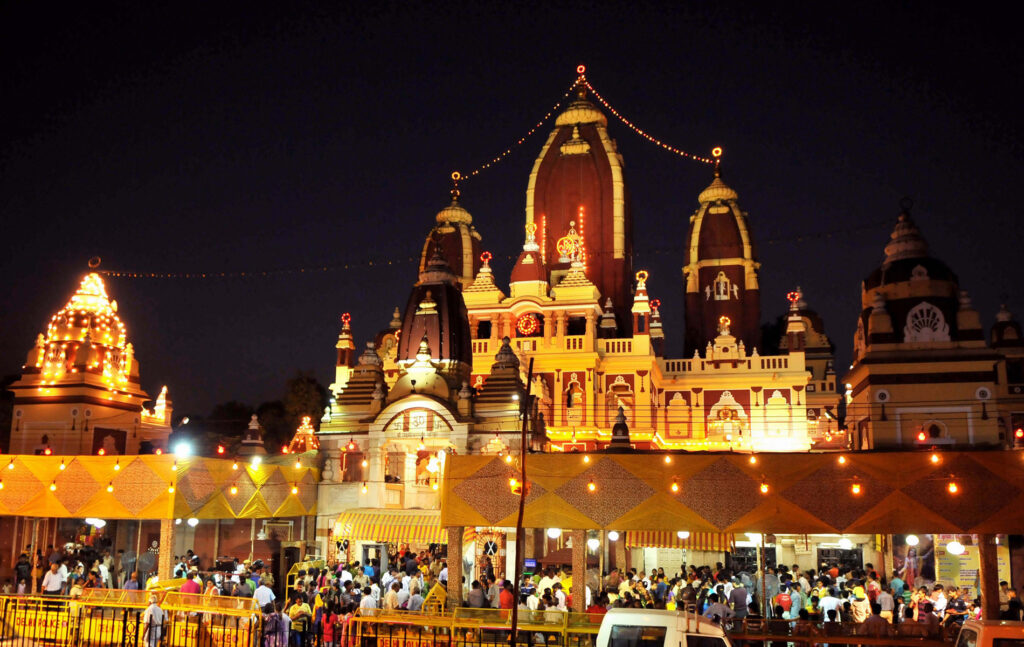
If you have time to fit in one more temple during your sightseeing tour of Delhi, it should be Laxminarayan Temple, also known as Birla Mandir. It’s also among the city’s newest of these locations.
Mahatma Gandhi dedicated this striking Hindu place of worship at Connaught Place in 1939 to the goddess of prosperity, Laxmi (Shrine of other faiths are also included on the site, a condition set by Gandhi). The grounds, which cover almost eight acres, are delightful to explore and include sculptures, lush tropical flowers, and fountains.
17. National Zoological Park:
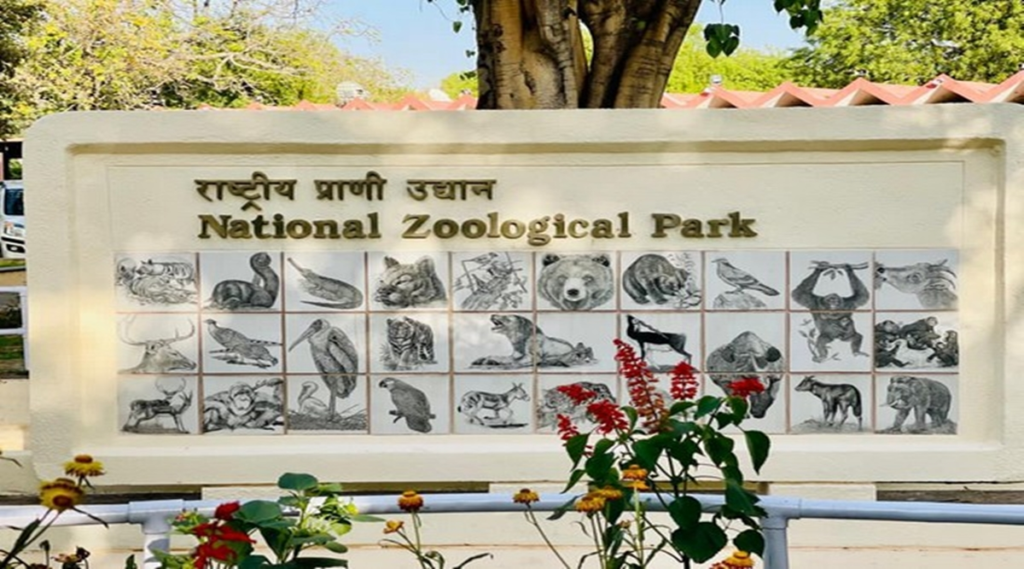
The National Zoological Park, regarded as one of Asia’s top zoos, was founded in 1959 and is home to some 1,500 different animal and bird species. There is a wide variety of wildlife on show, with many specimens from Africa, Australia, and Asia, representing all continents.
The zoo’s many chimpanzees, as well as its hippopotamuses, spider monkeys, zebras, hyenas, deer, jaguars, and tigers, are especially noteworthy. The underground Reptile Complex, which is home to a variety of snakes, including the deadly king cobra, is a kid-friendly attraction.
Taking a ride in one of the compact electric cars that cruise the zoo’s many attractions is a lot of fun.
18. National Craft Museum:
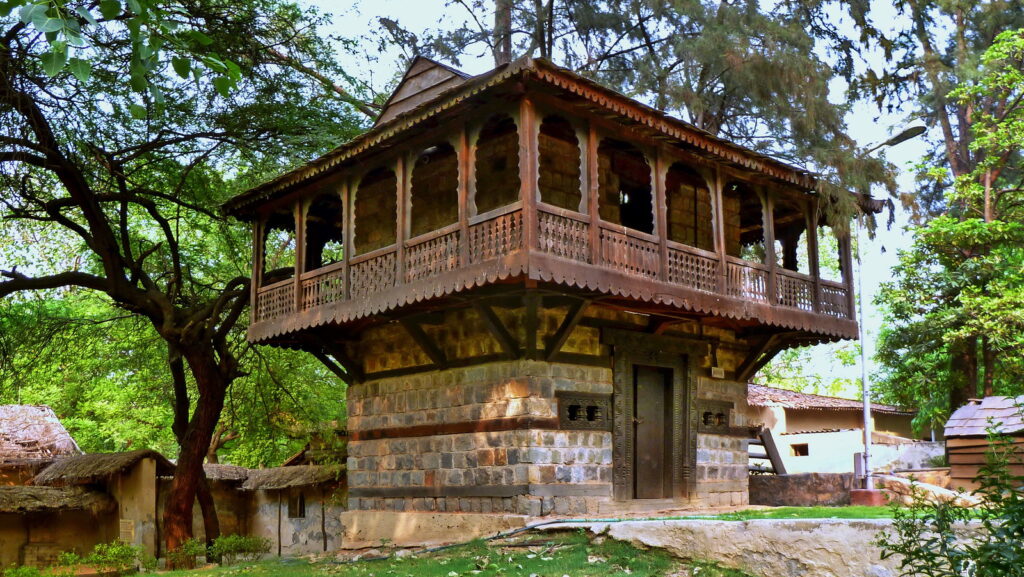
The National Handicrafts and Handlooms Museum, New Delhi, often known as the Crafts Museum, features a vast array of traditional Indian crafts. Seeing master craftsmen perform their centuries-old crafts and perusing vast collections of ceramics, woodwork, and textiles are just two of its many intriguing aspects.
The architectural displays of different regional villages are also worth seeing. These include real mud houses and a large wooden haveli (a type of mansion house) from Gujarat. that embellished with traditional folk art and has beautiful woodcarvings, paintings, papier-mâché, and embroidery.
19. National Rail Museum:

The National Rail Museum is a ten-acre facility that includes several vintage carriages and over thirty locomotives, the majority of which are extremely rare. This intriguing location has maintained almost 140 years of Indian railway history, including the 1885-built engine and the 1855-built Fairy Queen steam engine.
A collection of saloon cars owned by the nation’s once-powerful Maharajas, including the ivory-covered teak carriage of the Maharaja of Mysore. The Prince of Wales’s 1876 cabin, and the carriage in which Gandhi’s ashes were transported following his assassination in 1948 are among the other notable items. Also on exhibit is the skull of an elephant that hit by a mail train in 1894.
A trip on a great narrow gauge steam train is a lot of fun for kids.
20. Hauz Khas Complex:
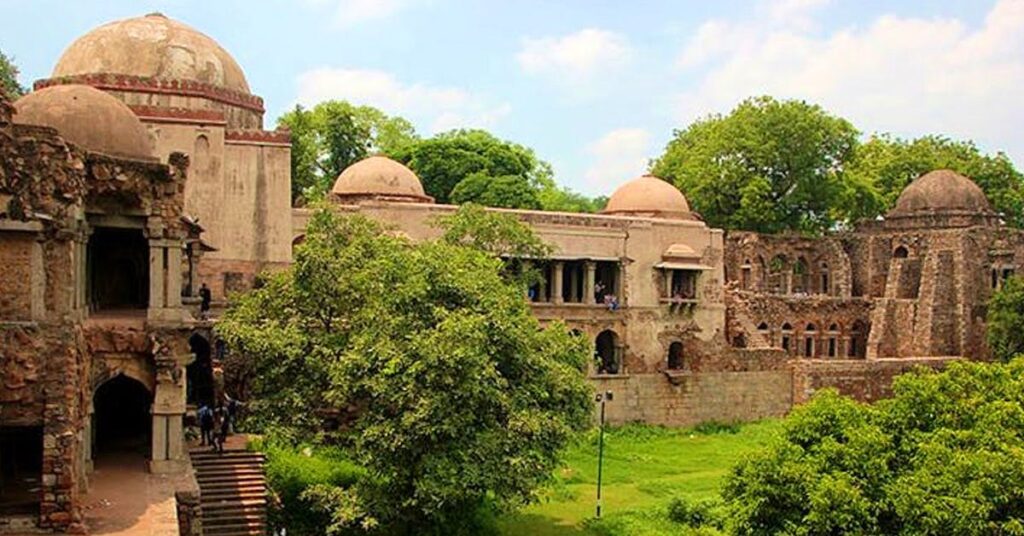
Slightly south of New Delhi, there’s an intriguing urban town called Hauz Khas Complex. The entire village littered with the domed tombs of lesser Muslim princes who buried here during the 14th and 16th centuries, in addition to the many old stone monuments.
Highlights also include the ruins of an old college, the tomb of Delhi’s 14th-century ruler Firoz Shah, and the exquisite Ki Masjid Mosque, which constructed in the Lodi style.
Make sure to factor in more time so that you can explore the neighborhood. Because of its trendy eateries, boutique stores, and art galleries, this lively neighborhood well-liked by both locals and visitors. It is also safe.
21. International Museum of Toilets:
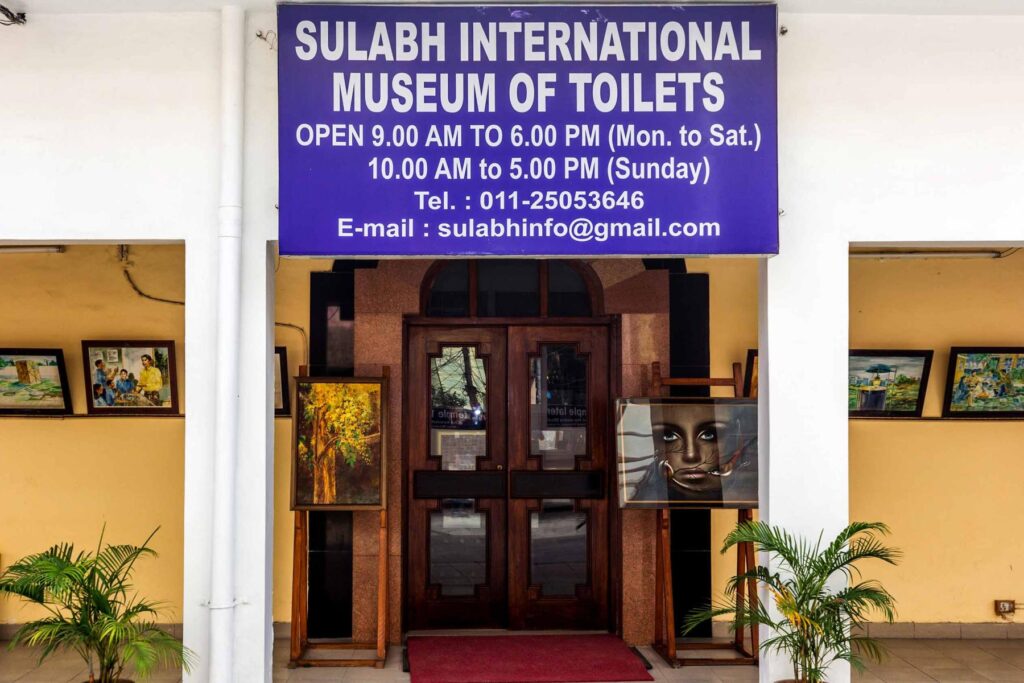
An interesting study into sanitation and its relationship to social reform may found in the Sulabh International Museum of Toilets. Exhibits illustrating historical trends coexist with objects related to toilets that date back to 2,500 BC, charting the history of toilet design across time.
A timeline of technological, social, hygienic, and toilet etiquette advancements presented through facts, images, and artifacts; displays include water closets, bidets, privies, and chamber pots from 1145 to the present.
Tibet House is a minor museum that is worth seeing despite having nothing to do with Tibet because of its collection of ceremonial objects that the Dalai Lama brought with him when he left Tibet. Along with a museum including a variety of unique art things, religious artifacts, ritual implements, instruments of war, and jewelry, the displays feature wooden sculptures, paintings, carpets, and ritual objects from Tibetan monasteries and villages.
For more information,click here.
Visit our official website, Travel India Info to plan your upcoming trips or mail us at info@travelindiainfo.com. We will be happy to assist you. Happy Travelling!!
Recent Posts
Europe Travel Guide: Best Places to Visit & Explore
15 Best Amazing Places to Explore in Scotland
9 Best Amazing Day Trip To Explore from Kyoto


